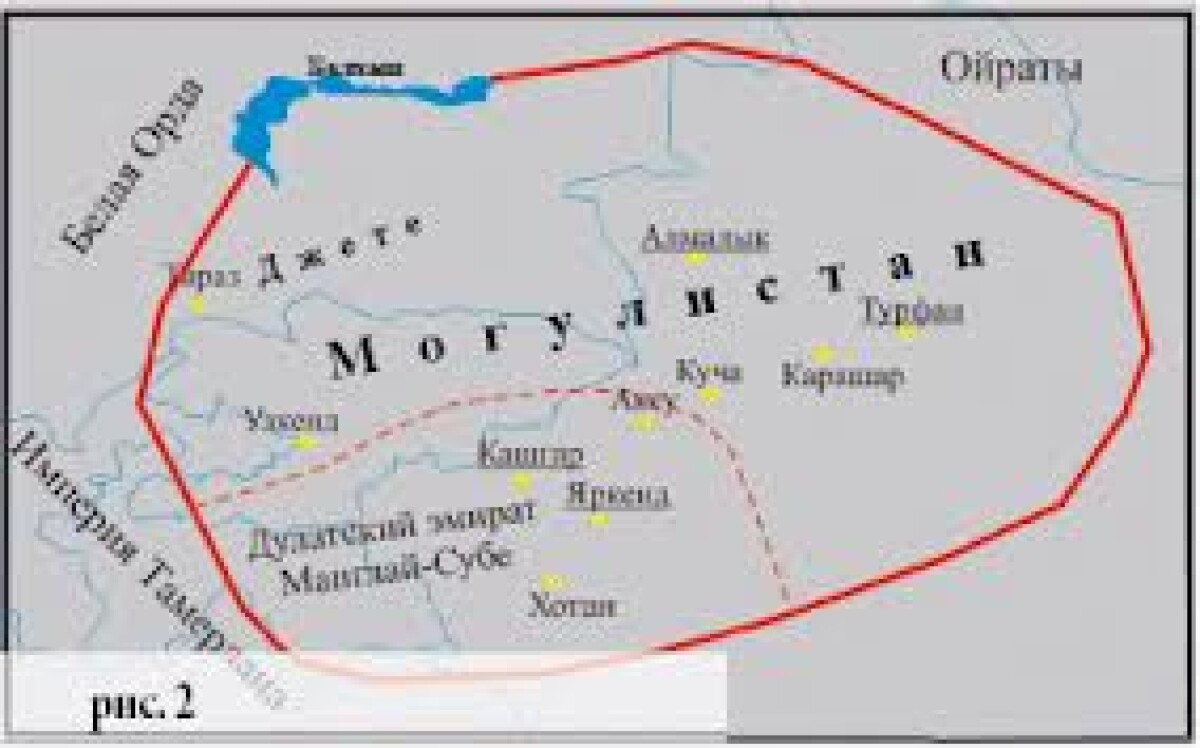
Moghulistan formed as a result of the fall of the Chagatai Khanate in south-eastern Kazakhstan in the middle of the 14th century. It became independent under Tughlugh Timur (1347-1362). Moghulistan was situated on the territory of Semirechye, East Turkestan and north-eastern part of Central Asia.
The boundaries of the state changed during its existence. They ran along the territory from Tashkent and Turkestan provinces in the west to Lake Barkul and the city of Hami in the east, from Balkhash, Tarbagatai and the Black Irtysh River in the north to Fergana and Kashgar agricultural oases in the south. The capital was Almalyk.
The major tribe in Moghulistan was the Dughlat tribe. The Dughlat emir Bulaji in 1347-1348 decided to raise a Khan of a new Chagatai Khanate of his own choosing. His choice fell on Tughlugh Timur.
The population consisted of Turkic and Turkicized Mongol tribes: the Dughlats, Kangly, Kereits, Wusun etc.
The word "Moghulistan" formed from the ethnonym "moghul." The word 'Mongol' was spelled and pronounced such way in Central Asia and Kazakhstan.
Social structure
• Khan was the head of state and supreme owner of the land;
• Ulusbek was the Khan assistant in government.
• There was a political and military council of aristocracy.
• There was a form of aristocracy landholding. In nomadic areas the land was in communal use.
• The types of duties - military, transport, labor, postage, etc.
Political history
Political history of Moghulistan was full of feudal wars, internecine strife and resistance against the attacks of neighboring states:
• First Khan of Moghulistan, Tughlugh Timur (1347-1362), for strengthening of the state held a number of administrative, political and economic reforms. Islam was used as an instrument of power. In 1361 Tughlugh Timur conquered Trasoxiana.
• Under the son of Tughlugh Timur, Ilyas Khoja (1362-1380), in Moghulistan began the period of feudal strife. Ilyas Khoja made efforts to strengthen the power of the Chagatayids, but continuous civil war resulted in dividing of the state into separate domains. In Semirechye dominated the Dughlat Emir Qamar ud-Din, in the Ili Valley and Tarbagatai ruled Enge-tore, and the Kangly and Karluk tribes remained free.
• In the 70's and 80's of the 14th century Emir Timur sent about ten victorious expeditions against Moghulistan. In 1371-1372 Timur himself marched on Moghulistan, reached Segiz-Igach in Issyk-Kul region and captured a large number of prisoners and booty. In 1375, Timur reached the Ili River through Sairam, Talas Valley and moved into Semirechye. In 1377, the army of Timur twice defeated Qamar ud-Din: first time in the foothills of the Karatau, and the second time in Boom Gorge, on the way from the Chu Valley to Lake Issyk-Kul.
• By the end of the 80s formed a political alliance of the rulers of Moghulistan and the White Horde against Timur. In response to the union of the forces against him, Timur organized two of the most difficult campaigns for the indigenous people of Kazakhstan: in 1389 against Moghulistan, and in 1390-1391 against the White Horde and the Golden Horde. As a result of a grueling fight against aggression of Timur Moghulistan was divided into domains. The Khan of Moghulistan Kyzyr Khoja (1380-1399) was forced to acknowledge himself a vassal of Timur. In the first half of the 15th century the Timurids continued to take control of Semirechye and Kashgar.
• Under the son of Kyzyr Khoja, Muhammed Khan (1408-1416) the state strengthened. Under him Moghulistan became independent from the Timurids. He managed to return the lands in the Chu and Talas Valleys. Internecine strife stopped for a while. Mohammed continued conversion to Islam.
• In the first half of the 15th century from the eastern borders of Moghulistan the Oirat incursions began. The Oirats were the westernmost group of the Mongols (in Central Asian sources they were called Kalmyks). Uais Khan (1418-1428) organized the fight against them. He had to move his residence from Turfan to Ilibalyk in Semirechye.
• After the death of Uais Khan the power of Moghulistan slowly declined. The internecine struggle was won by the son of Uais Khan, Esen Buga (1433-1462). In the late 50's of the 15th century part of tribes led by the sultans Janybek and Kerey migrated from East Dasht-i-Kipchak into Semirechye. Esen Buga Khan gave them land in the valleys of the Chu and Talas Rivers, where they formed the Kazakh Khanate.
In the second half of the 15th and in early 16th centuries the rulers of Moghulistan tried to strengthen their position, but the constant war for possessions weakened the state.
